Reparing scratches on 50's blonde mahogany
I recently bought a dresser and vanity from an antique store made by Landstrom furniture. I have heard that Landstrom was a company founded by Danish immigrants that produced furniture of quality on par with Widdicomb. It is from the 50's and has a MCM/Hollywood Regency vibe with gorgeous, heavy oversized nickel and brass chinoiserie pulls and it is blonde mahogany. The vanity has a gorgeous bow in the front. Generally it is in better than average shape for furniture of this age, but there are some light scratches on the tops and some small scuffs and dents on the legs.
I am not really sure if I want to keep the blonde color. It is attractive but not sure if it really fits my decor scheme. I have seen pictures of the exact furniture in a dark brown finish on 1st dibs going for in excess of $5,000. I have considered having it sprayed high gloss white or refinishing it in a darker brown color.
Before I do that, I want to see how it would look if I restore the existing finish. Can anyone help me? I applied some denatured alcohol and the finish got soft and tacky, so I think it may be shellac, but I've also heard that some kinds of lacquer will do this as well.
Should I try this Restor A Finish stuff? If so, what color to use? Obviously, they don't make a blonde color.
Here are some full shots and some close ups of some of the damage:

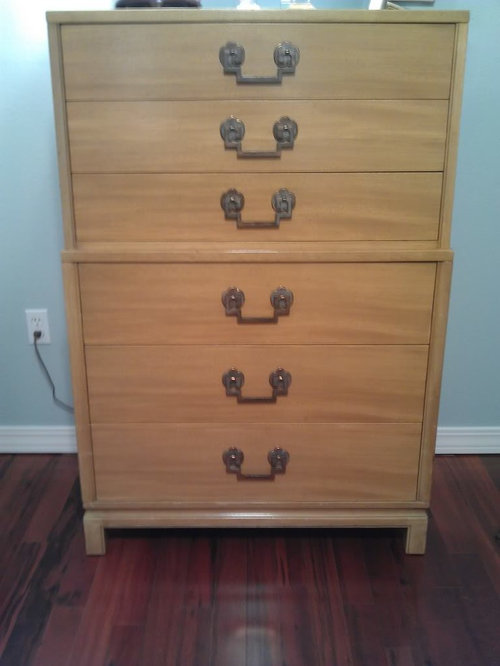
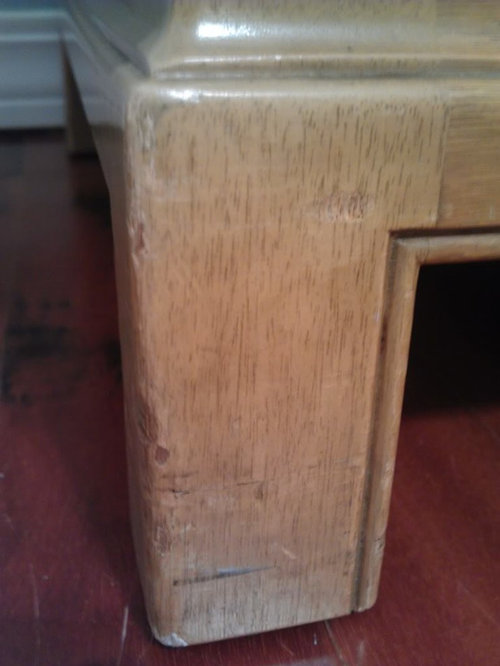

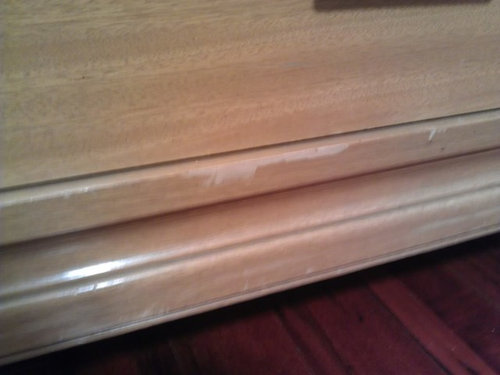
Comments (37)
sombreuil_mongrel
12 years agoProbably worth employing a furniture touchup specialist, rather than bugger up that fine set with household nostrums.
The specialist can make the stuff look nearly new.
Caseybobismyuncle
12 years agoI'm not really a fan of Restore-a-finish. It seems little more than a goosed up polish to me. In a few weeks, things don't look any better.
And, yes, 60 year old lacquer might be softened with denatured alcohol.
>. I have considered having it sprayed high gloss white or refinishing it in a darker brown color
Be aware that gloss finishes will both tend to show every defect and are quite fragile to scuffing when things are set or slid on them. I've even had and seen gloss finishes that get scuffed by ordinary dusting.
I did a couple of 1950s bedroom sets last year. It was the most awful (IMHO) color -- a semi-transparent gray paint top coated with a raw umber (green). We went to a dark mahogany on both of them at owner's request.
Related Professionals
Annapolis Carpenters · Escondido Carpenters · Kissimmee Carpenters · Lake Worth Carpenters · Miami Carpenters · Summerlin Carpenters · Beacon Flooring Contractors · Burlington Flooring Contractors · Kendall West Flooring Contractors · Pahrump Flooring Contractors · Topeka Flooring Contractors · Springdale Furniture & Accessories · Little Chute Furniture & Accessories · Pleasant Grove Furniture & Accessories · Rogers Furniture & Accessoriesjockewing
Original Author12 years agoAny ideas on a ballpark figure on how much a pro would charge? How do I go about choosing one?
Also, I have heard that changing from the original finish will devalue the piece. Admittedly, I bought the pieces because I think they are beautiful and I want to use them in my house, not really as investment pieces. So I am not THAT concerned about the authenticity. I found a picture of a piece from the same line in a dark brown finish and it is gorgeous. The hardware stands out even more:
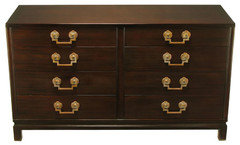
I paid under $600 for both pieces (plus the bench). I would be willing to spend up to that much to have them refinished. Am I dreaming, or is that feasible?
Mikk
12 years agoI agree with Bob (especially when it comes to the restor-a-finish.. uh.. how do you put it nicely?), and I think you would be looking at a pretty penny to employ a profession to give you the whole shebang. Most of what I can tell from the photos could very easily be a DIY job, but those leg gouges really could use a good burn-in.
Without a midieval dip strip and spray refinish, I don't think you could find someone to do a decent refinish job within the $ figure you mentioned. Might depend on what part of the country you live in, however.
The most noticable seems to be the top scratches, but they don't seem to be all that deep. If you were to strip the piece, it would be very simple to do a little hot water treatment to raise the grain then do a resand to completely eliminate those.
Really nice pieces though for the price. Ya done good!
bobismyuncle
12 years agoFrom someone who apparently watches too much Antiques Roadshow, "Also, I have heard that changing from the original finish will devalue the piece"
Not true very often.
Where are you located? I may be able to refer you to someone.
Here is a link that might be useful: the antiques roadshow myth
jockewing
Original Author12 years agobobsmyuncle, thanks for clearing up that myth for me. Like I said, I did not purchase this set as an investment, I bought it to use and admire everyday.
I had a furniture man come look today and he quoted me about $800 to have the pieces stripped, stained, and varnished. I believe I am going to have this done. The man said he loves jobs like these--working with good quality furniture--and that he is excited to get started on it. That makes me feel good and that I would think he will probably do a good job with the furniture. I told him I would like it to have a glossy wet-look finish and he said he would probably use an oil based varnish. Opinions on that?
He did mention the very remote possibility that some of the yellow pigment may be hard to get completely out of the wood and that would cause some additional difficulties, but he said he doubted this would be the case. Bobsmyuncle, do you have any experience with these blonde stains and how well they strip?
I am thinking of going with a mid tone brown with just a hint of red and gold for richness. Something in between say a light walnut and a teak maybe? Any suggestions for ways to pick out the best stain color?
I sort of like the color on both of these pieces. Maybe I should go for something in between these colors?
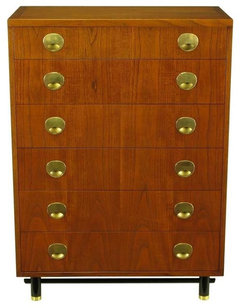

bobismyuncle
12 years agoI don't generally have problems going from light to dark, but dark to light is a bit more difficult. There are all sorts of products - dark pore filler, glazes, toners, dyes, and pigments that can help get or push the color,
I think you should end up with an attractive piece.
And I agree, well-built pieces are a joy to work on compared to the Asian stuff I see most every day. I usually mentally shake my head and wonder how this ever made it out of the finish room and final inspection.
jockewing
Original Author12 years agoBobs--
Are there any red flags I should look for that would tell me he's not the right guy for the job? I liked that I saw all the stain around his fingernails! He's been in the business for 20+ years and from talking to him he seemed to know his stuff. He commented on several of the pieces in my house so I think he's a genuine furniture guy.
He said he will completely strip first. He said he's not gonna do tons of sanding to get rid of every single scratch. He said he didn't want to damage the patina of the wood and any scratches would look like a natural part of the piece and would be virtually unnoticeable with a new darker finish (esp. since most of the scratches are actually in the finish and not the actual wood itself).
Next he said he will have me come in the shop to pick the finish and to bring in any pics of pieces I like the color of. Finally he said he will go with an oil based varnish for some shine and protection.
Does all this sound about right?
Also, any opinions on a color? I really hate wood with too much orange or red, but I think you do need some in there for richness.
Mikk
12 years agoI'm new to this forum, but I've read enough of Bob's posts that I can tell that he knows his stuff. I'll let him respond, however, my only 2 bits would be that my main concern would be "how" this fella intents to strip your pieces.
From the limited amount of comments I've read.. I would say your guy seems to know his stuff, but since you're planning on a full strip, I might take the opportunity to deal a bit more with the scratches. What he told you isn't really all that untrue ("would look like a natural part of the piece"), but since you're "there"... might as well try and refresh the pieces as much as possible. KWIM?
To avoid affecting the patina of the pieces I would probably just try to raise the grain a bit and do a sand-off.
As for the top coat... Varnish would work well, keep it more "in period", and add to the overall "depth" over time, but I still might consider a poly for durability. Just a thought.
As for the finish, and from what I've seen of your posts so far, you might take a gander at an oil based medium walnut. It seems that minwax is mentioned quite a bit around here, but I'm kind of a GF fan myself. :-)
Whichever route you go, I hope you'll follow up with us and post some photos. :-)
bobismyuncle
12 years agoGood responses in my absence.
I am not a fan of the strip tanks. I regularly see chairs that have been in the hot bath and it does damage to the glued joints. A much better system, in my opinion, is hand stripping (that should be easy enough with this flat and square piece) or a "flow-over" system where you apply a stripper, let it sit for a while, then start up the recirculating pump and flow more stripper on while you brush the old finish off. I use my flow-over primarily for chairs where there are lots of parts and detailed areas.
The only surprising thing is that he wants to use an oil-based varnish. This is a fine finish, but most finishers I know will choose a finish that is sprayable. It's just so much faster. I can spray a chair in under a minute and the last chair I brushed (a Morris chair, if that makes any difference), took about 3 hours to brush two chairs and two ottomans. I sprayed a shellac sealer on them in less than 10 minutes, including time to jostle them around in my spray booth.
I'm not really a fan of Minwax either, its main advantages seem to be cost and availability. Some good oil-based varnishes are
* Waterlox
* Behlen Rockhard
* Pratt & Lambert #38
* Cabot 8000 series (used to me McCloskey's Heirloom prior to merger/acquisition)
* Sherwin-Williams Fast Dry (Alkyd)These are all non-poly varnishes. If I had to use a poly varnish, I'd probably choose General Finishes Arm-R-Seal (a wiping poly (not an oil-urethane blend as the label would lead you to believe, a varnish), or Cabot Poly.
someone2010
12 years agoThe problem I see are the dents. Some can be sanded out, some can be steamed out, and some will need to be patched. You can make a jig for splining the edges and cut a matching piece of wood, with dovetail endings
. I have done this and have had to tell the customer which side I repaired.
Since this is the web, and anyone can claim anything, I direct you to some books that explain this technique: 1.RESTORATION RECIPES BY JAMES BAIN SMITH AND JULIA BIERRE 2.FURNITURE RESTORATION BY INA BROSSEAU MARX AND ALLEN MARX 3.HOW TO RESTORE ANTIQUE FURNITURE BY COLIN HOLCOMBE and a plethora of similar books you can purchase on line.
With a router, a simple homemade jig, and a hand plane one can do a very creditable job, very hard to detect.Fori
12 years agoI think that you should keep it the original color and decorate around it--it's perfect for those pieces and gives them a great midcentury feel. The dark-stained piece is very pretty but generic.
Mikk
12 years agoAs far as the baseboard "dents"... a simple burn-in should work nicely.. quick.. durable.. and cost effective. The size and location hardly require the effort and expense mentioned. Granted.. a bit deep to try and raise the grain, but a full splining would be cost prohibitive, and, quite frankly.. a waste of time for what you are trying to accomplish.
sombreuil_mongrel
12 years agoA light and dull finish is more forgiving of dents/dings/gouges than a very dark piano polish finish (which shows every thumbprint, much less any surface defects).
Caseyjlusk999_gmail_com
12 years agoIHe is finished stripping and I am going to meet him at lunch so I can bring him a wood floor sample that is about the color I decided on. It is a walnut-- not too dark and a nice rich medium brown. I wonder if I can ask him to mix in a little yellow to give it a slightly golden richness? I want the piece to look as rich as possible with as much depth as he can get. What would be the best finish to achieve that look? Varnish? Lacquer? Shellac?
jockewing
Original Author12 years agoSo he is finished stipping and I brought him a sample of a kind of golden walnut color to match.
He stained the pieces and I went to look today to see if the color was right. I have to say I wasn't really impressed when I saw how things looked. The stain frankly look kind of uneven and the "ribbons" in the mahogany looked way too stripy. Some of the drawers looked like a tiger! I said I wanted a more uniform color and he kept saying "the woods gonna do what the wood's gonna do to a certain extent". He said he applied the stain with a brush but he wants to spray another thin layer on to even out the color.
Now I don't have much experience refinishing furniture, but will it magically come together when the varnish is applied? He told me beforehand not to expect to see a finished looking product with just the color applied. But why am I seeing pronounced stripes and then no depth where the stain is lighter? It looked so beautiful when he was stripping the blonde off of it and I could see all the beautiful grain. It looks so dull and almost grayish now.
Maybe I am overreacting? Here are some not so good pics:
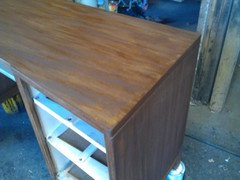

sombreuil_mongrel
12 years agoThe problem with using a dark pigment stain on mahogany is what you are seeing. The pigment takes into the porous grain "stripes" and makes them dark and muddy. A varnish will up the ante, making the effect more pronounced.
Caseyjockewing
Original Author12 years agoSo casey, what is the solution? What are you supposed to stain mahogany with? In person, the stripe parts don't look that bad, its the lighter parts that look like they have no depth to me. Do you think his plans to spray another light coat will help even out the color?
Does this look like a bad job to you?
sombreuil_mongrel
12 years agoIt could have has a sealer applied before stain, which would prevent the pigment from muddying the grain. And/or a dye stain used, which does not have the kind of pigment that muddies the grain.
Too late for either. I'd apply a sealer, and then a very dark toner that will approach the dark color of one of your example pictures. You can always go darker, not possible to go lighter. To eliminate the effect of objectionable streaks, it's going to need to go nearly as dark as the streaks.
Have him use a sanding sealer as the first of his finish coats, and look at it while it's still wet; that will tell you what to expect if finished as-is, then you can ask him to make any changes you see needed.
Caseyjockewing
Original Author12 years agoI was thankfully pleasantly surprised when I saw the pieces today. The varnish has improved it immeasurably. This is in the full sunlight with one more sanding and a final coat of varnish to go:

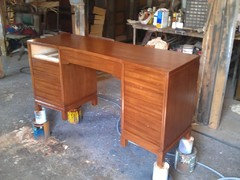
sombreuil_mongrel
12 years agoIt looks great, but you were originally concerned about the end panels, based on the first set of pictures.
But I have some more confidence in his abilities based on these pics.
Caseyjockewing
Original Author12 years agoFinished product:
My only problem is the top of the vanity is not really smooth. The man said a lacquer finish would be smoother, but he wanted the durability of the varnish. He said over time the finish will dull to a glow and the top will smooth. I have seen different "rub out" techniques on the web that can create a smooth finish. Wonder if I should try that? Also, thinking about polishing up the handles. I believe the pulls are copper and the plates are nickel.


jockewing
Original Author12 years agoCan anyone tell me what to do to smooth out the tops and the best way to polish the copper pulls and nickel plates?
jockewing
Original Author12 years agoCan anyone tell me what to do to smooth out the tops and the best way to polish the copper pulls and nickel plates?
jockewing
Original Author12 years agoCan anyone tell me what to do to smooth out the tops and the best way to polish the copper pulls and nickel plates?
jockewing
Original Author12 years agoCan anyone tell me what to do to smooth out the tops and the best way to polish the copper pulls and nickel plates?
sombreuil_mongrel
12 years agoDue to the shape of the polyurethane molecules (crosslinked polymers) it can't be successfully buffed out without becoming more hazy. "The molecules tear rather than cut" is the simplest explanation. Shellac, old-fashion oil varnishes, or lacquer cuts cleanly, and can be rubbed out with abrasives to good effect.
The hardware question. I see that the brassier tone is at the expected area of wear. This informs me to say that the two-tone effect you are witnessing is the top layer of the plating (probably nickel) wearing off exposing the copper plating or solid brass beneath.
a) this has past the original intention of the designer; the clean nickel hardware was the original appearance.
b) you can polish with Flitz or Simichrome.
c) the two tone look is going to get worse with each polishing, as more nickel is worn away, the copper may also polish off and reveal base metal, which if Zamac or suchlike is not capable of taking a polish.
Replating is the most desirable fix, but it's expensive and it can be very hard to locate a plating shop in some areas (mine, for instance).
Caseyjockewing
Original Author12 years agoSorry, I don't know how that post was repeated 4 times!
Overall, I am I guess relieved that it didn't come out looking bad, per se, but I will not ever be using that guy again. He claims that the tops will get smooth over time and the glossiness will fade. From a glance, it's not bad, but it isn't anywhere close to a really fine job, either.
I am really distressed at how RED the top of the vanity looks when I turn on the lamps. It almost looks like it has a maroon or oxblood tone, which I did not want AT ALL! Of course I'll probably learn to ignore it over time, but it has me wondering how much it would cost to have a piece of carrara marble cut to put over the top (which would get rid of the rough surface issue at the same time). I could probably find a remnant at a stone yard that wouldn't be too much because it's not a real big top.
I did not see this maroon tone at all in his shop and I don't really see it from the front--its only when I turn on a lamp. I've tried different kinds of bulbs and it doesn't help. You can see faint brush strokes and bubbles in the tops. At first glance I guess it looks fine, but it really bothers me that I went to all this trouble and cost for a less than acceptable result. Of course he went on about how "a finish is gonna do what it's gonna do" and it's almost impossible to control how smooth the top is. Interestingly, the dresser top is much smoother than the vanity. Would it have come out better if he would have sprayed the finish on? He admitted lacquer would be smoother, but he doesn't like to use it because it is not as durable. He said I could throw my pieces in a swimming pool and they would survive due to the varnish. Well I really don't plan on ever doing that so I would have preferred something that is better in the environment the furniture will actually be in--a climate controlled home.
My luck with tradespeople and so called "professionals" continues to fail. I live in a suburb of New Orleans of close to 100,000 residents. I would think in a town of this size I could find pros, but I guess I'm gonna have to go to the city next time to find somebody really good.
I hope these pieces grow on me. As of right now, I'm almost wondering if they should have remained blonde......
RRM1
12 years agoI'm assuming the tops were brushed on using an "oil-based" varnish and not polyurethane. The tiny bumps you see on the top can be fixed. What probably happened is he used the wrong type of brush and it didn't flow out properly. It just needs to be leveled and re-coated. That means sanding the finish with fine sand paper if, and when, the finish is hard enough. I use P-350 or P-400 wet and dry and use water (or Wool lube)with a block, I prefer a cork block. What you're seeing could be due to a number of things, but not using a good varnish brush and not thinning the varnish enough didn't allow the finish to flow out and level itself. Using the right varnish brush and thinning slightly will correct some of your problem. (and the right varnish)
My first choice would have been to spray a lacquer finish and then rub it out. But this can still work for you if he used an old school varnish and not poly. Oh, your concerns about redness might be mitigated to some extent by exposing it to sunlight since old-school varnishes "yellow" in sunlight.
Richardjockewing
Original Author12 years agoI'm gonna call him today and find out exactly what type of varnish he used. He specifically called it oil varnish several times and I think I remember him saying it was not poly but I'm not positive. So if is old style varnish, could I do a steel wool rub followed by paste wax? Id be willing to spend the time rubbing out the whole thing to get rid of that shinyness and to burnish the finish
RRM1
12 years agoI think leveling is a more important next step. That means using something flat and fairly rigid behind your abrasive first, to get it flat and level (read smooth) is more important, then another finish coat, then if you want to rub it out, it's up to you.
jockewing
Original Author12 years agoOh boy. Just called him and found out that of course he used Minwax polyurethane! I wonder why he didn't just say that. I sure wish I knew what I know now when I hired him. I would have specified a different stain color and probably for him to use lacquer. I probably should have had him do one piece first to make sure I liked his work and then done the other after.
So is there anything I can do now?
sombreuil_mongrel
12 years agoYou can wet sand it with 1500 grit, and then use a wipe-on satin poly/gel varnish. It will not have any nubs at least.
CaseyRRM1
12 years agoThe guy is not a pro. Live and learn, I guess, but don't panic, just slow down a little and take it a step at a time. Remember, polyurethane is still a varnish, although one with a different resin. What Casey had to say (above) is basically true, however, it can be sanded, not sanded clear through the finish, but sanded flat(180 or 220). In some ways, it might make things a little easier, sanding-wise.
First, go to a professional paint store, not a consumer or DIY-type place and ask if they have a really good real varnish. Also ask if you can use it over Minwax Poly. Epiphanes makes a very decent tung oil/phenolic resin varnish. It is pretty expensive,[about $50 a quart] but Hey, you're into it now. There will be other varnishes, most will be OK too. The resin is the important thing, the varnish needs to be hard, at least hard for a varnish. You'll need a couple of other things, as well. 1. A good brush, that is a good varnish brush. [I have several different types, badger is good but a lesser quality than than some other types. I have one I bought in Europe for over 100 dollars.] Don't go too crazy. But they will last forever, if taken care of. 2. A good thinner for cutting your varnish and for clean-up. I use Pure Gum Spirits Turpentine for cutting and mineral spirits for clean-up, but I'm sort of obsessive (in addition to furniture, I also do/have done brightwork on many boats) Also get a supply of sand paper and a sanding block for leveling.
I'm going to stop here for a second and offer a different option. Find a custom cabinet-maker in your area and ask him to recommend a commercial finisher, you still might be able to spray lacquer over what you now have. I just have no experience with polyurethane and can't say for sure. You might also be able to both, tone your current finish to correct the color and "even-ness" and lacquer it also.
Let's stop here before going on, and see what you find out and finally decide to do. My email is on file here, if you need some personal attention.
merrillmorgan799
6 years agoThis is an old thread (or whatever it is called!) so keeping fingers crossed for a reply from you experts. I have my blonde solid mahogany bedroom suite from about 1950 in a guest room. It was/is in great shape except my dad used it from age 79-96 so the dresser top is kind of a mess from beverage glasses, keys, pliers, etc. . Scratches are very superficial. I want to keep it (and the whole suite) blonde, but any suggestions? I've cleaned it with Murphy's oil soap and vinegar-water, then a water rinse, but it still looks "bad" tho I can live with it. Would something like Krud Kutter destroy the finish? Other suggestions? Thank you!


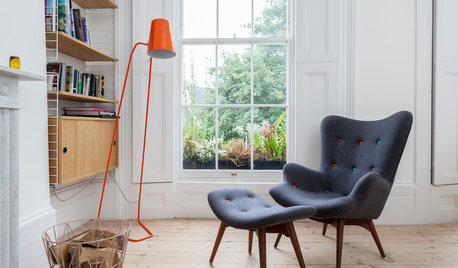
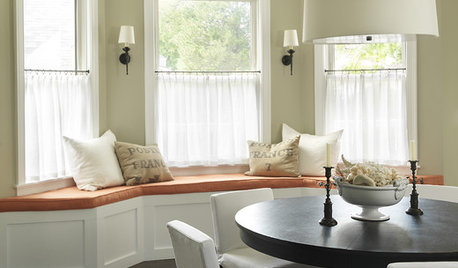
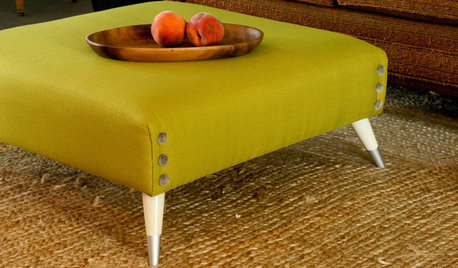

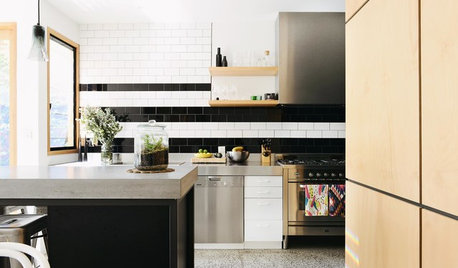
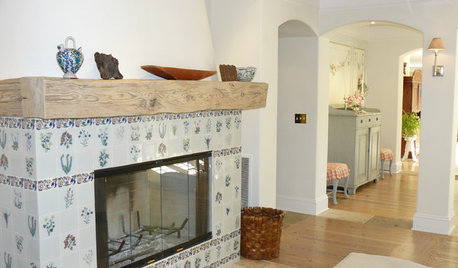
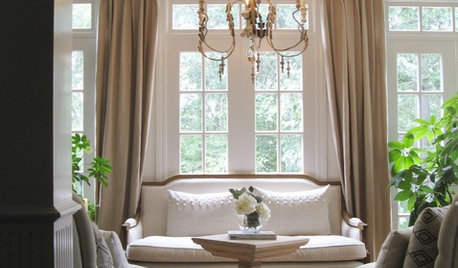










sombreuil_mongrel